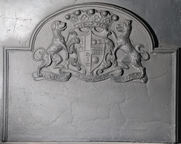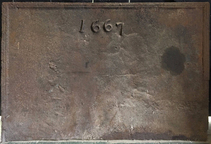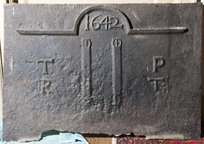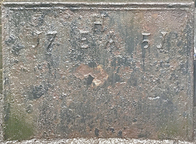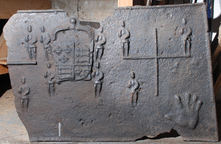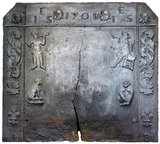-
250
Description: Arched rectangular shape; astragal and fillet edging; shield, motto, earl’s coronet and supporters (a talbot erm. and a wolf or, ducally crowned gu.) of Stanhope impaling Pitt: quarterly (1st & 4th) erm. (2nd & 3rd) gu. (Stanhope); sa., a fess chequy az. and ar. between three bezants (Pitt); motto: A DEO ET REGE.
Notes: James Stanhope was created 1st Earl in 1718; he had married Lucy Pitt in 1714. The Stanhope seat was Chevening, near Sevenoaks.
Inscription: A DEO ET REGE
Arms: Stanhope impaling Pitt; James, 1st Earl Stanhope
- Decoration tags:
- rectangular with round arch (shape)
- astragal & fillet (edging)
- carved pattern panels
- armorial
- text
Manufactured: in the early-18th century in England.
Current location: Chevening Park, Chevening, Kent, England.
- Attached to series:
- Personal armorial firebacks
- Stanhope series
-
1085
Description: Rectangular; rebated ovolo-moulded edging (top, left and half-right sides); top centre, date with unevenly positioned numerals.
Notes: The asymmetry of the side moulding is unusual.
Inscription: 1667
- Decoration tags:
- rectangular (shape)
- rebated ovolo moulding (edging)
- carved stamps
- individual numbers
- text
Manufactured: in 1667 possibly in the Weald area of England.
Current location: Faversham, Kent, England.
- Attached to series:
- Date only firebacks
- 1660s-90s Wealden series
-
1104
Description: Rectangular shape; plain edging (top and sides); full-height impression of a fireback of arched rectangular shape and ovolo edging; date in arch; below arch, two parallel straps, each with a buckle at the top; initials T above R to the left of centre, and P above T to the right.
Notes: The side edging of the original fireback has been erased before casting. A variant of the 1642 series of firebacks bearing the Pelham buckle badge and the initials TP, believed to relate to Sir Thomas Pelham (1597-1654). It is not known to whom the initials RT relate; their style suggests they are contemporary with the original fireback. A larger fireback has been created by impressing either the original pattern of the Pelham fireback or a casting from it into a plain rectangular mould, and modifying it by removing the side moulding. It is unclear whether the additional initials, RT, had already been added to the 'pattern' or were added to this casting.
Inscription: 1642 / T P / R T
- Decoration tags:
- rectangular (shape)
- plain and ovolo (edging)
- whole carved pattern
- individual letters
- individual numbers
- planklines
- text
- objects
Manufactured: in the mid-17th century possibly in the Weald area of England.
Current location: in private hands, Isleworth, London, England.
- Attached to series:
- 1642 Pelham series
- Pelham family firebacks
-
1169
Description: Rectangular shape; cyma reversa moulded edging (top and sides); top centre, initials EHA in triad; date split each side of initials.
Notes: Well formed and well spaced letters and numbers.
Inscription: 17 EHA [triad] 51
- Decoration tags:
- rectangular (shape)
- cyma reversa/ogee (edging)
- individual letters
- individual numbers
- text
Manufactured: in 1751 in England.
Current location: not known.
- Attached to series:
- Date & initials firebacks
-
661
Description: Fragment; quasi-rectangular; twisted rope edging (top and sides), cavetto edging at bottom; originally, probably a symmetrical arrangement comprising a central, crude crowned, Tudor royal shield, with a standing human figure, its right arm bent at the elbow and its left arm crossing its waist, repeated in upper and lower positions on each side of the shield; to left and right, a twisted rope length repeated in the form of a cross, with the human figure placed above each transverse end and another below the cross and towards the shield; in the bottom corner(s), a (left) hand print.
Notes: The same crowned shield and use of hand print can be seen on a fireback at Etchingham (no. 60), indicating a common source.
Arms: Tudor royal
- Decoration tags:
- rectangular (shape)
- simple stamps
- carved stamps
- armorial
- royal
- humans
- objects
Manufactured: in the early- to mid-16th century in the Weald area.
Current location: Hole Park, Rolvenden, Kent, England.
-
890
Description: Canted rectangle; cavetto moulded edging (top and sides); single horizontal fillet below canted corners and vertical fillet parallel to each side, dividing the fireback into two side panels, two top corner panels, top panel and main central panel; corner panels, ‘daisy’ plant stamp; top panel, date between ‘daisy’ stamps, between initials in triad at each end; side panels, swirling foliage stamp repeated each side above a fleur-de-lys, above initial 'I' on left and 'B' on right; centre panel, stamp of ‘Indian’ smoking a pipe at top left, stamp of seated ‘gentleman’ smoking a pipe and holding another, at top right; below each, a seated monkey stamp, that on the left seated facing right, its paws in front of it and its tail below, that on the right seated facing left, its tail drawn across its chest.
Notes: The IB initials are identical to those on similar firebacks dated between 1703 and 1721, probably indicating the same founder. The number 3 of the date and the fleur-de-lys on the lower left side have been over-pressed showing the backs of the stamps. The use of stamps relating to tobacco smoking may suggest an origin near Bristol, the main entry port for the tobacco trade at that time.
Inscription: IES [triad] 1703 IES [triad] / I B
- Decoration tags:
- rectangular with canted top corners (shape)
- fillet (edging)
- carved stamps
- heraldic
- text
- animals
- humans
- plants
Manufactured: in 1703 in the Forest of Dean area of England.
Current location: Greys Court, Rotherfield Greys, Oxfordshire, England.
Museum number: 196857 (part of the National Trust museum group)
- Attached to series:
- IB series
- Date & initials firebacks
